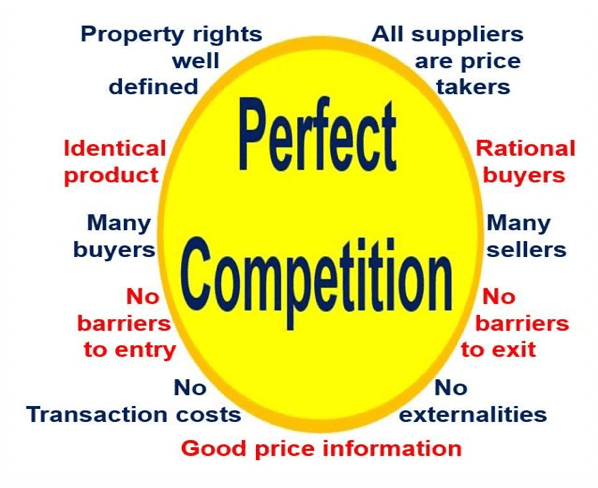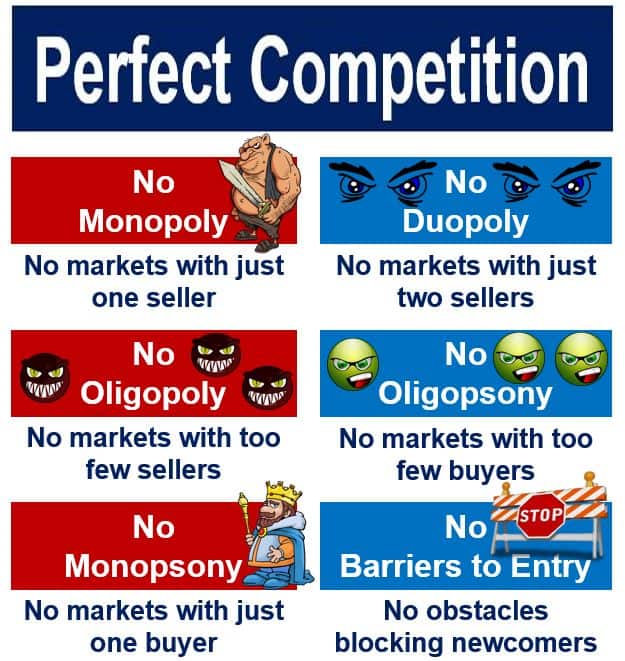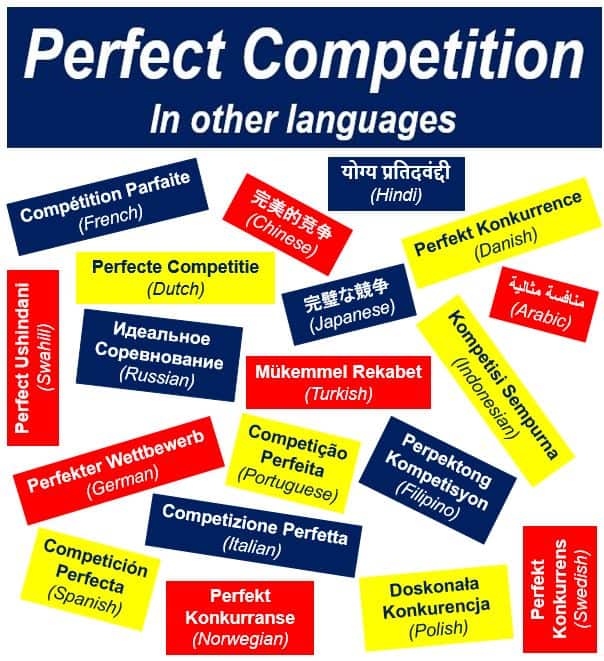Perfect competition, also known as pure competition or a perfect market, is the market economy at its finest, the most competitive market possible, a market where there are no monopolies, duopolies, oligopolies, oligopsonies or monopsonies.
In a market with perfect competition, conditions are so ideal that any individual seller or buyer has no significant impact on prices.
Perfect competition is the opposite of imperfect competition, where the ones who call the shots are frequently in a position to abuse their power.
 Will perfect competition ever exist, or will our nature – we are deceitful, greedy, and prone to bullying and abusing power – prevent it from ever occurring?
Will perfect competition ever exist, or will our nature – we are deceitful, greedy, and prone to bullying and abusing power – prevent it from ever occurring?
Perfect competition is a theoretical condition
Most economists across the world agree that perfect competition is incredibly rare, in fact, most of them believe that we have never seen one in real life – it does not exist, and never has.
In the perfect market everyone is a **price taker, companies earn only normal profits – the bare minimum profit required to keep them in business – information is perfect (everybody knows everything about a product), and products are homogeneous.
** A price taker is a company or seller that has to accept the prevailing prices in the market of its own goods and/or services, because its own transactions cannot affect the market price. It is the opposite of a price maker; a company, such as a monopoly, that sets prices.
In a market with imperfect competition, companies earn more than the bare minimum – they earn excess profits – and the barriers to entry mean that other competitors are unlikely to enter that market.
 All markets in the world have at least one of the features listed in this image, thus making them imperfect markets. The defense industry in the USA, for example, is a market monopsony – the Department of Defense represents nearly all purchases. Lockheed Martin, a US defense giant with over 120,000 workers, gets 85% of its revenue from US government contracts.
All markets in the world have at least one of the features listed in this image, thus making them imperfect markets. The defense industry in the USA, for example, is a market monopsony – the Department of Defense represents nearly all purchases. Lockheed Martin, a US defense giant with over 120,000 workers, gets 85% of its revenue from US government contracts.
With perfect competition, excess profits by one firm are soon balanced out, because the absence of barriers to entry means that competitors do enter the market and push down price levels until only ‘normal’ profits are made.
In a market with perfect competition, output is at its maximum while prices are as low as they can be.
Perfect Competition – features
– Buyers and sellers: there are lots of them. The many consumers are willing and able to buy the product or service at a certain price.
The large numbers of sellers are willing and able to supply a product or service at a certain price.
– Rational Buyers: consumers or buyers are involved in transactions purely to increase their economic utility. No trades are made that do not increase their utility.
Rational purchasing vs. emotional purchasing behavior: if you buy a car because you need a better and more convenient way to get around, that is a rational purchase, you are a rational buyer. If, however, you buy that car to impress your neighbors and friends, that is emotional buying, you are an emotional buyer.
– Zero Transaction Costs: in a market with pure competition, purchasers and sellers do not incur costs when buying or selling goods or services. Fees you have to pay the middle-man, lawyers, brokers, etc., are examples of transaction costs.
– Perfect Information: both the seller and buyer in every business transaction know all the prices of products and services, as well as the utilities each person would get from owning that product or receiving that service. For example, there are no car salesmen telling potential buyers that that car was well maintained, when in reality it is two crashed vehicles welded together.
– Homogenous Products: the products and services are perfect substitutes for each other. The features and qualities of a market product or service do not vary between different sellers.
– Perfect Factor Mobility: all the factors of production – labor, capital, entrepreneurship, etc. – are perfectly mobile, which allows for free long-term adjustments to changes in market conditions.
– Property Rights: are clearly-defined. These determine what rights are conferred on the purchaser, as well as what may be sold.
– Price Takers: – there is not one seller, such as a monopoly, that can set prices. All suppliers know they cannot influence prices, and therefore accept them.
 Perfect and imperfect competition are both terms that economists across the world talk about frequently.
Perfect and imperfect competition are both terms that economists across the world talk about frequently.
– Barriers to entry/exit: there are none. Examples of barriers to entry are government regulations, startup costs, special technology, economies of scale, product differentiation, and collusion by some suppliers to keep others from entering.
Barriers to exit are, for example, extremely high costs involved in leaving a market. If barriers to exit are too high, a company may be forced to continue competing in that market.
– No Externalities: third parties are not negatively affected by the costs or benefits of an activity. This criteria also excludes any intervention by the government.
– Sellers’ Profit Maximization: companies sell where they can generate the most profit, where marginal costs and revenue meet.
– Non-Increasing Returns to Scale: the lack of economies of scale ensures that there are always enough sellers or suppliers in that industry.
Perfect competition = perfect equilibrium
When perfect competition prevails – because conditions are just right – markets will reach an equilibrium in which the amount supplied for every good or service, including labor, equals the level of total demand for them at current prices.
In this equilibrium, it is not possible for one person to be made better off by exchange at the cost of somebody else –a Pareto optimum.
Examples of perfect competition
Although no economy or market in the world today or in the past has ever had perfect competition, there are some that get pretty close.
– Stock Exchanges: by design, these are places with a large action of identical goods with all the potential purchasers and sellers present.
However, stock exchanges do have a number of flaws. Some huge institutional investors, such as investment banks, can influence market prices on their own, which violates the ‘no one seller can influence market price’ condition of pure competition.
– Betting on the Horses: when placing bets, gamblers (consumers) can simply look down the line to determine who is offering the best odds. It is not possible for one bookie to offer worse odds than those that are being offered in the market as a whole, because consumers will simply switch to another supplier (bookie). In this sense, all the suppliers are price takers.
In the world of horse-race betting, the product on offer is extremely homogenous – the only differences between each bet are the horse and the pay-off.
There are, however, some barriers to entry – to become a bookie you need capital to set up as well as a license.
– Free software: this works along lines that approximate the conditions of perfect market very closely. Any person is free to enter or leave the market without incurring costs.
All software code is freely modifiable and accessible, and each player is free to behave independently. Free software can be purchased or sold at whatever price the market will allow.
– Street Food Vending: in developing countries. Conditions in this market are very close to those that exist in perfect competition.
There are relatively few barriers to entry/exit, there are many buyers and sellers, and everybody possesses perfect information of the product being sold and bought.
Often, street vendors offer a homogeneous product, with very little variation in its features.
One major flaw in some types of street food vending are mafia-like behaviors. Informal gangs claim territories, which they are forever defending or trying to expand.
If an outsider tries to sell inside their territory, he or she is likely to be threatened or even attacked, or maybe find that nobody is buying (consumers are scared).
Video – Ground rules for perfect Competition
This Khan Academy video gives us some of the ground rules for perfect competition.
